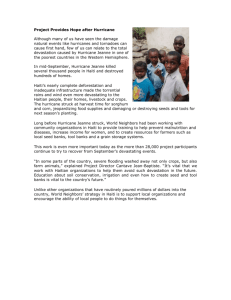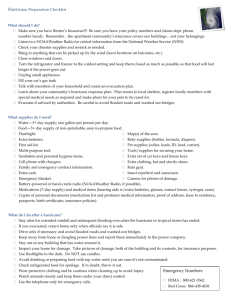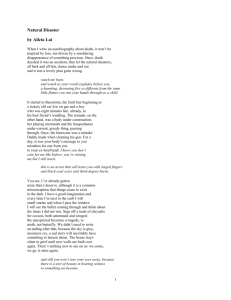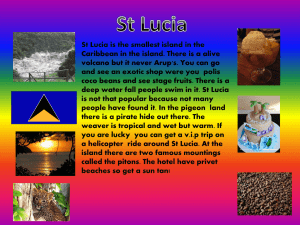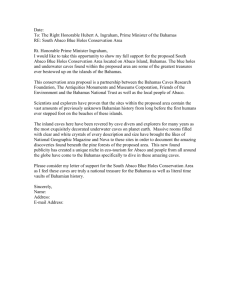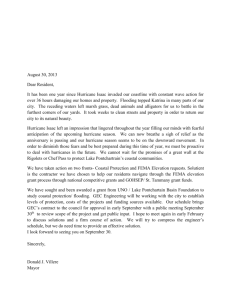02Introduction
advertisement
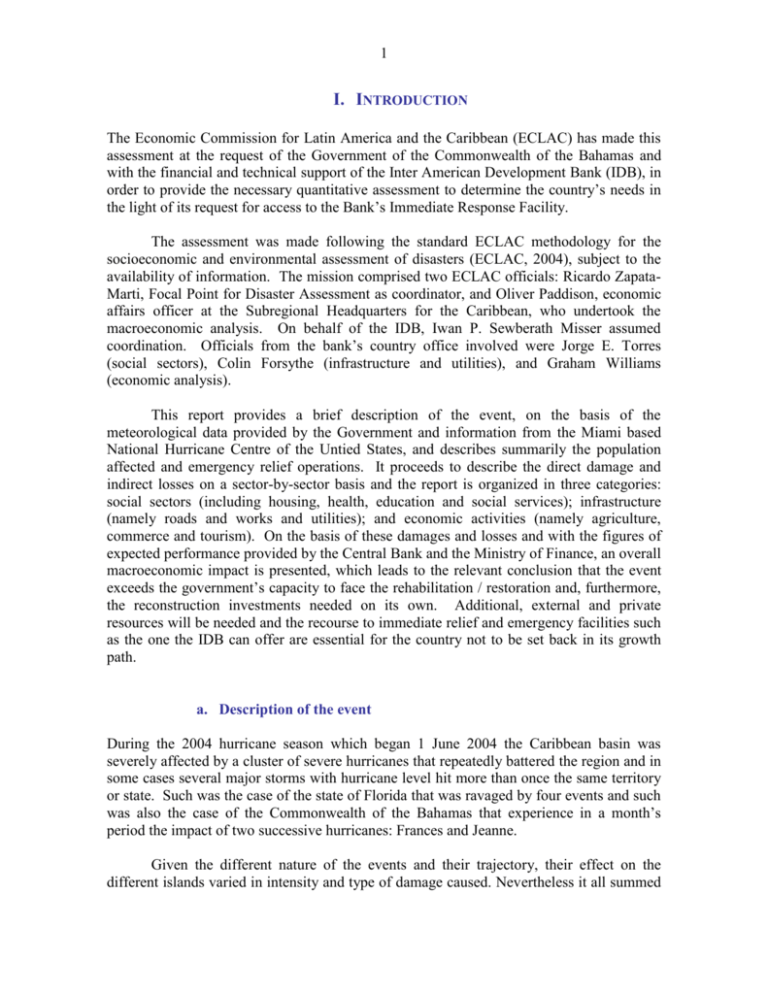
1 I. INTRODUCTION The Economic Commission for Latin America and the Caribbean (ECLAC) has made this assessment at the request of the Government of the Commonwealth of the Bahamas and with the financial and technical support of the Inter American Development Bank (IDB), in order to provide the necessary quantitative assessment to determine the country’s needs in the light of its request for access to the Bank’s Immediate Response Facility. The assessment was made following the standard ECLAC methodology for the socioeconomic and environmental assessment of disasters (ECLAC, 2004), subject to the availability of information. The mission comprised two ECLAC officials: Ricardo ZapataMarti, Focal Point for Disaster Assessment as coordinator, and Oliver Paddison, economic affairs officer at the Subregional Headquarters for the Caribbean, who undertook the macroeconomic analysis. On behalf of the IDB, Iwan P. Sewberath Misser assumed coordination. Officials from the bank’s country office involved were Jorge E. Torres (social sectors), Colin Forsythe (infrastructure and utilities), and Graham Williams (economic analysis). This report provides a brief description of the event, on the basis of the meteorological data provided by the Government and information from the Miami based National Hurricane Centre of the Untied States, and describes summarily the population affected and emergency relief operations. It proceeds to describe the direct damage and indirect losses on a sector-by-sector basis and the report is organized in three categories: social sectors (including housing, health, education and social services); infrastructure (namely roads and works and utilities); and economic activities (namely agriculture, commerce and tourism). On the basis of these damages and losses and with the figures of expected performance provided by the Central Bank and the Ministry of Finance, an overall macroeconomic impact is presented, which leads to the relevant conclusion that the event exceeds the government’s capacity to face the rehabilitation / restoration and, furthermore, the reconstruction investments needed on its own. Additional, external and private resources will be needed and the recourse to immediate relief and emergency facilities such as the one the IDB can offer are essential for the country not to be set back in its growth path. a. Description of the event During the 2004 hurricane season which began 1 June 2004 the Caribbean basin was severely affected by a cluster of severe hurricanes that repeatedly battered the region and in some cases several major storms with hurricane level hit more than once the same territory or state. Such was the case of the state of Florida that was ravaged by four events and such was also the case of the Commonwealth of the Bahamas that experience in a month’s period the impact of two successive hurricanes: Frances and Jeanne. Given the different nature of the events and their trajectory, their effect on the different islands varied in intensity and type of damage caused. Nevertheless it all summed 2 up to an affectation that was unusually high, even in a territory that is yearly affected with varying degrees of severity. In brief, hurricane force winds with Frances first and torrential rains with Jeanne immediately after were experienced in Mayaguana, Long Island, San Salvador, Rum Cay, Cat Island, Eleuthera, New Providence, the Berry Islands, Abaco and Grand Bahama (see map in figure 1) Figure 1: Map of the Bahamas The Bahamian archipelago is intrinsically vulnerable, in addition to man-made conditions associated to its development pattern, given its conformation of a large number of small islands, cays and islets distant from each other amidst a vast expanse of water. In effect the nucleus and largest proportion of the Bahamian territory is its patrimonial sea. Figure 2 shows the trajectories followed by both events, showing that the northern part of the Bahamian territory was the most affected one, particularly hit in both instances the islands of Abaco and Grand Bahama. 3 Figure 2: Hurricanes Frances and Jeanne trajectories HURRICANE FRANCES TRAJECTORY HURRICANE JEANNE TRAJECTORY Source: www.met.fsu.edu, Tracking chart and images here are courtesy of Dan Vietor of the Unisys Corporation. Given the size of both phenomena Figure 3. Hurricane Floyd in fact all of the Bahamian territory was covered by them at some point in time and thus no island was spared from suffering some level of damage, either associated with storm surges, very high wind forces or persistent high levels of rainfall. The previous similar level of hurricane to hit the archipelago had been Hurricane Floyd in 1999 (see figure 3). Ensuing damage included in some instances associated flooding that persisted for several days, cutting in effect communications and impeding accessing with necessary aid in the immediate aftermath. See figures 4. Hurricane Frances, an open water type storm, was the sixth one named and the fourth hurricane of the 2004 season in the Atlantic. Historically it was the first since 1886 to impact the entire Bahamian archipelago.1 Because of its slow motion and very large eye (roughly 140 km in diameter) the centre of circulation remained over the northwestern part of the territory for an extended period of time (from 2 to 5 September). The storm had developed in late August: at 11 p.m. Tuesday 24 August already satellite images indicated that a tropical depression had formed from a strong tropical wave in the Eastern Atlantic, some 1,400 km. West-southwest of Cape Verde, moving west at 28 km per hour. The next day, at 5 p.m. it was upgraded to tropical storm status and given a name, being further 1 According to the Bahamas Department of Meteorology report. 4 upgraded on 26 August at 5 p.m. It rapidly reached the category 3 level in the SaffirSimpson scale the next day and progressed to 4 in a 24-hour period. Although it fluctuated over the next few days it reached a peak wind force of 240 km per hour on September 2 at 2 a.m. and with that force passed directly over the island of San Salvador and very near to Cat Island already in the Bahamian archipelago. Figure 4: Extent and coverage of Hurricanes Floyd, Frances and Jeanne over the Bahamas Sept. 3, 2004 — At 11 p.m. EDT, the centre of Hurricane Frances was located near latitude 26.1 north, longitude 77.8 west or about 70 miles east-southeast of Freeport, Grand Bahama Island. Sept. 20, 2004 – At 500 p.m. EDT, Jeanne strengthened back into a while slowly moving north. During the next four days, Jeanne would make a clockwise loop over the Atlantic ocean, northeast of the Bahamas. Source: www.noaanews.noaa.gov Table 1 shows the meteorological statistics for Frances from 30 August to 5 September. Table 1: Meteorological Statistics of Frances on its passage in the Bahamas Lat ºN Long ºN Intensity Pressure Location (mb) 8/30/2004 17:00 19.5 60 207.5 948 1430 km ESE of Mayaguana Date/time 8/31/2004 17:00 9/1/2004 5:00 20.5 21.2 65.9 68.5 232.4 232.4 939 935 797 km E of Inagua 473 km ESE of Mayaguana 02 Sep 2 am to 2 pm 22.7 72.5 240.7 937 58 km northeast of Mayaguana 9/2/2004 23:00 24.5 75.4 207.5 948 9/3/2004 20:00 25.9 77.5 174.3 960 05 Sep noon 27.7 81.2 174.3 - 42 km ESE of Arthur’s Town, Cat Island 149 ESE of Freeport, Grand Bahama 266 km northwest of West End, Grand Bahama Source: Bahamas Meteorological office. 5 Recovery had not even begun when Hurricane Jeanne, the 10th named tropical cyclone of the 2004 season, hit the Bahamas 25 September. After developing from a tropical depression 116 km east-southeast of Guadeloupe on the evening of Monday 13 September and having reached Puerto Rico on the 15th with 1116 km per hour winds, Jeanne moved across that island with extreme amounts of rain only to gain force as the sixth hurricane of the season before hitting the eastern tip of Hispaniola on September 16. It moved slowly across the northern tier of that island. In its passage it had serious consequences while weakening to a tropical storm, dumping over 30 cm of rain across portions of the Dominican Republic2 and Haiti. In this last country over two thousand inhabitants of the city of Gonaives died from flooding and mudslides resulting from the heavy rains. At that point it seemed the storm would slowly fade away into the northeastern Atlantic as it weakened to a tropical storm on the 17th, becoming disorganized while slowly moving north. But on the 19th it strengthened again while making a clockwise loop over the Atlantic Ocean, northeast of the Bahamas and developing into a formidable hurricane again with maximum sustained winds of 160 km per hour. It blanketed the northern islands of the archipelago, particularly Abaco and Grand Bahama while completing its loop and moving to the Florida peninsula where it hit on 25 September with category 3 force again, moving onshore on the 26th. Hurricane Jeanne made landfall in the Bahamas on Saturday, 25 September, damaging several hundred homes. Jeanne, a category 3 hurricane, struck the Bahamas just three weeks after Frances Flood waters rose to more than six feet in some areas and roofs were blown off houses. Hurricane Jeanne impacted the north-western Bahamas, including Abaco, Andros, Berry, Bimini, Eleuthera, Exuma, Grand Bahama and New Providence islands. It caused the most significant damage on the Grand Bahama and Abaco islands. Based on a survey from representatives of the Bahamas Red Cross Society and a disaster management delegate from the Pan American Disaster Response Unit, it became clear that damage from Hurricane Jeanne just added to that caused by Hurricane Frances. Almost all of the areas affected by Hurricane Jeanne are the same areas that were struck by Hurricane Frances, and many homes that were weakened by Frances have now been more seriously damaged by Jeanne, and those that had lost their roofing were soaked with the extraordinarily strong rains. All along the coast of Grand Bahama Island, homes have been flooded by the storm surge. Electricity services have been cut and water supplies are limited in many areas. In 8 Mile Rock, the largest community on Grand Bahama Island, over 75 percent of the homes have suffered serious structural damage, with roofs partially or completely torn off. All shelters in 8 Mile Rock sustained structural damage and/or flooding. The eastern half of the island has been cut off by storm surges and reports indicate significant flooding of homes, particularly along the coastline. In the city of Freeport on Grand Bahama Island, the airport was flooded but was reopened the following day. Communications were cut off with Abaco Island after Jeanne's eye passed directly over the island on Sunday, 26 September, bringing 115 mile per hour winds and heavy 2 For a report on the impact in the Dominican Republic, see: LC/MEX/L.638, 29 October 2004. 6 rains. Preliminary reports indicated that the most populated town of Marsh Harbour had been significantly flooded. Officials reported that about 700 people had taken refuge at an emergency shelter that was set up in a local school. The primarily Haitian settlements of Pigeon Pea and the Mud were completely submerged in four to five feet of water. Families in these areas are staying in shelters or with relatives. Cooper's Town and Dundas Town have also been greatly damaged. b. Population affected 3 The passage of both hurricanes, in spite of its strength, intensity and duration and the physical havoc it created, had minor consequences in terms of human lives. Two deaths occurred in the Bahamas, one in New Providence and the other in Freeport, Grand Bahama4 as consequence of Hurricane Frances and more than 8,000 people in Grand Bahamas Island were affected. On the verge of September 25, when Hurricane Jeanne tracked directly over the islands of Abaco and Grand Bahama, the National Emergency Management Agency of the Bahamas (NEMA) reported that approximately 2,500 people were evacuated to emergency shelters; however, that number decreased immediately as water levels recede and families return home. NEMA reported that no deaths or injuries related to Hurricane Jeanne have occurred. Near Marsh Harbour on Abaco, four to five foot water levels from Hurricane Jeanne damaged an estimated 90 percent of the Mudd and Pigeon Pea settlements, where the majority of the population is Haitian and Bahamian-Haitian. In addition, approximately one-third of the homes in the town of Sandy Point suffered water damage, and several homes experienced extensive roof damage. Throughout the island the combined effect of both storms in such a short period of time is severe. Not only the economic effects of the disaster are still apparent, with many hotels, farms and other businesses damaged, but the psychological effect of the consecutive events has been quite devastating. Businesses slowly reopened but employment is not yet to pre-disaster levels. See PAHO, “Hurricane Frances situation report: 06 Sep 2004”, 7 Sept 2004, and IFRC, “Hurricane Jeanne appeal no. 23/04”, 1 November 2004 (www.reliefweb.org) 4 In the first instance an 18 year old man was reportedly electrocuted when he tried to refuel a generator; and in Freeport the storm surge of 14 feet (4.3 mts) drowned a young man. 3 7 The situation in Abaco remains particularly severe in the above mentioned settlements of Pigeon Pea, the Mud, and Sandy Banks. Many families are still unemployed or are working only part-time. Many roofs are still damaged and give limited protection from rainfall. Washing and bathing are done with brackish well-water. Bottled water must still be purchased for drinking.5 In the North of the Island, Cooper's Town, Fox Town and Crown Haven are recovering. Streets have been cleaned, power and water has returned in most areas, and repairs are being made to homes and businesses. In these towns families have also been affected by the economic shock and incomes have been reduced. Fortunately, the situation is not as critical as in the Haitian settlements, as the standard of living was much higher prior to the disaster. In addition to over three thousand houses affected by Frances, Hurricane Jeanne damaged approximately 800 houses and affected a total of 5,000 families on Abaco and Grand Bahama Island. Over 3000 thousand houses were affected with different degrees of damage, most of them in Grand Bahama. At some point all of the population of Grand Bahama was left without electricity and water supply was severely affected for several days. Table 2 shows the proportion of primarily affected population. Table 2: Primarily affected population 2 Deaths a/ 2,400 People in shelters Secondarily affected population (in all regions) Affected immigrant population in settlements (Abaco) 13,500 15,000 Percentage of total population 9% Tertiary affected population (as percentage of total population) 58% Source: ECLAC, on the basis of official information from the Reliefweb (www.reliefweb) a/ Three injured were reported by the Ministry of Health c. Emergency relief 6 The response from the Bahamas Government was swift. The first news item on Frances was issued by the Bahamas Department of Meteorology at 6 a.m. August 25th. The first alert was issued five days later, at 6 a.m. on August 30th, covering the Turks and Caicos and the southeast Bahamas. Because of the slow movement of Frances over the northwest Bahamas warnings were discontinued in two stages, trying to maintain population aware of its passage and avoid casualties. A total of 21 news items and 45 alerts were issued during the storm’s passage. After Jeanne the islands of Abaco and Grand Bahamas were declared disaster areas by Prime Minister the Right Honourable Perry G. Christie on September 27. Both islands, in the northern Bahamas, sustained substantial damage from Hurricanes Frances and Jeanne. The Government has appealed for regional and international assistance to provide immediate emergency relief to the residents of both islands and also for the reconstruction which is to follow. 5 ECHO is in the process of approving an emergency assistance for these settlements. Unless otherwise specified, dollar amounts are expressed in current Bahama dollars, which are equivalent o one US dollar. 6 8 At the outset, actually previous to the hurricanes arrival on the territories, NEMA established mechanisms to channel assistance, both provided by the Government and by private donors and international cooperation, including NGOs. A few days after the initiation of operations the SUMA7 accounting system was put in place and both a central command and field distribution centres were established. According to the series of reports prepared by the Suma-trained officials, distribution has been efficient and demand driven in terms of identifying the needs at the community level and organizing distribution of consigned materials from the central warehouse in Grand Bahama to the different locations in the family of islands. In order to operate the system at first, given the lack of electrical power in Freeport, Grand Bahama, immediately after the event, they resorted to using the manual version of SUMA and had to adapt it to their local needs and capabilities. Table 3 summarizes the consignments received till the 26th of October. Table 3. Consignments of emergency relief assistance received in the Bahamas, by item (NEMA/SUMA) (Bahamian dollars) Water supplies Food provisions Construction materials Stoves, fuel, etc. Total cash donations Other not included above TOTAL $4,869.44 $282,242.79 $318,165.97 $492.00 $400.00 $24,975.28 $606,170.20 Source: SUMA These consignments are only a fraction of the assistance provided, which has been estimated in excess of 1,7 millions of dollars. Government reactivated the Disaster Relief and Recovery Fund (Act of 1999 proclaimed after Hurricane Floyd). Deposits are to be applied only to emergency relief concerns and proceeds of the fund will not be used to repair or reinstate public infrastructure. As of 1 October 2004 the fund had received some 4,5 million of Bahamian dollars in donations and pledges. 7 The Humanitarian Supply Management System (SUMA) was developed by the Pan-American Health Organization (PAHO/WHO) and has become the standard system to keep track of emergency and relief supplies after a disaster. Officials of the Bahamas had previously been trained in the system through the PAHO office in the country and were in a position to implement the system soon after the first hurricane hit the country. 9 In order to further assist in the recovery and reconstruction process Government has signed four orders of Exigency to allow the duty free importations of goods and construction materials that will be in effect till December 2004. Table 4 describes these orders, their duration and goods covered. A detailed list of donors and contributing agencies and the materials received is not included in this report but is available from NEMA, and was made public by the Prime Minister in his report to Parliament of 6 October, 2004. That report provides a comprehensive description of the first assessment made after hurricane Frances and includes an addendum on Jeanne. Most of the damage described in it is of a direct nature (assets lost or damaged), referring extensively to the effects on housing and on public services and public infrastructure. Table 4: Commonwealth of the Bahamas Declarations of Exigency after the hurricanes No. Duration Coverage 1 3-10 Replaced by orders 2 to 5 September 2004 2 3 September – Grand Bahama, allows durty free import of batteries, building materials, 31 December clothing / footwear, disposable paper goods, plates, cups, forks, spoons, 2004 etc.; electrical materials; emergency communications equipment; foodstuffs including water; generators; household furniture, appliances and utensils; medical supplies; plumbing materials; storage containers for water, garbage, etc.; tools, chainsaws, etc.; water pumps and motor vehicles (in the latter based on the market value of the vehicle destroyed on the dates of the hurricanes). 3 3 September – Abaco and the Cays, San Salvador, Berry Islands, Rum Cay, Acklins, 31 November Crooked Island, Long Island, Cat Island, Mayaguana, Eleuthera, including 2004 Harbour Island, Spanish Well and Current Islands. Same goods as specified in the Schedule for Grand Bahama. 4 3 September – For application in islands not in orders 2 and 3. Application for 31 December importation of motor vehicles must be made to the Minister of Finance 2004 prior to the act and the exemption will be be based on the market value of the vehicle destroyed on the date of the hurricane. 5 3 September – Grants exemption to hotels licensed under the Hotel Act and to tourist 31 December attractions, for goods which the Minister is satisfied are intended for the 2004 relied of such facilities that have suffered damage as a result of Hurricane Frances Source: Prime Minister’s report to Parliament, 6 October 2004.
